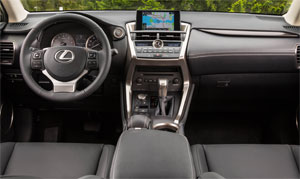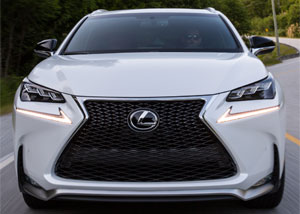2015 Lexus NX
Another episode of MotorWeek, another new compact crossover to check out. Or so it seems of late. But wait, this one is also luxurious! Sorry for the cynicism, but with all the downsized, fancied up crossovers we’ve driven lately it’s a bit like our road test playlist is stuck on repeat. But, we haven’t heard from one of the kingpins of affordable luxury yet: Lexus. That in until now with their all-new NX.
The 2015 Lexus NX is just the latest in a shifting crossover landscape to smaller luxury-minded utes. It’s hard to say whether it’s the search for additional fuel economy or the realization that maybe we don’t need so much space after all that’s powering the shift; but Americans are buying into smaller utilities of all types in larger numbers.
And while the benefits are obvious, so are the compromises, as there’s less area to spread out, as well as less space for cargo.
Most interior measurements of the NX are very similar to the Toyota Rav4 on which the NX shares basic underpinnings. Except for cargo space which due mostly to a faster roof is much less, at 17.7 cubic-ft. behind the rear seats and 54.6 with them folded.
 While unmistakably Lexus, the NX design is another clear step in the brands attempt to trade a soft image for a more dynamic one. Indeed, when you step inside things are much more “sporty” than over the top luxurious. Even the seats are sport-minded, yet still very comfortable. And the tight space with wide center console also implies sportswear more than business casual.
While unmistakably Lexus, the NX design is another clear step in the brands attempt to trade a soft image for a more dynamic one. Indeed, when you step inside things are much more “sporty” than over the top luxurious. Even the seats are sport-minded, yet still very comfortable. And the tight space with wide center console also implies sportswear more than business casual.
Rear seats however, feel more generous; and more in-line with what you expect in a luxury-minded crossover. And you can take it further still if you go the F SPORT route, which instead of the usual cow and tree materials, things go black and metallic.
Front seats are even more aggressive, and the LFA-inspired gauges, with boost gauge and G-meter, set the tone when you trigger the start button. There are aluminum pedals for your feet, a unique steering wheel with paddle shifters for your hands, and for your ears, Active Sound Control that lets you dial in as much engine sounds as you want.
Those sounds come from the first turbo engine ever in a Lexus. It’s a 2.0-liter unit with an integrated intercooler and exhaust manifold, and a twin-scroll turbocharger. Output is 235-horsepower and 258 lb-ft. of torque.
 It’s a sweet engine. Both smooth running and quiet when you want it to be; powerful and aggressive when you don’t. And it works very well with the standard 6-speed automatic transmission.Lexus claims a 0-60 time of 7.0-seconds.
It’s a sweet engine. Both smooth running and quiet when you want it to be; powerful and aggressive when you don’t. And it works very well with the standard 6-speed automatic transmission.Lexus claims a 0-60 time of 7.0-seconds.
In addition, there’s also a hybrid NX 300h. It uses a re-tuned version of the Camry’s 2.5-liter I4 gas-electric system with total output of 194-horsepower. And like the Highlander, all-wheel-drive is available with the addition of a motor generator mounted in the stern that drives the rear wheels.
Government Fuel Economy Ratings are yet to be finalized, but Lexus claims 21-City, 28-Highway, and 24-Combined for an all-wheel-drive 200t; and 35-City, 31-Highway, and 33-Combined for a front-wheel-drive 300h.
For our early drive time around Whistler, British Columbia we naturally chose the athletic F Sport and were not disappointed. Handling is great, nothing at all like the rolling couch-like manner of the RX. Handling is aided by the front axle’s “pre-load” differential.
But as much as we were enjoying the nimbleness, the rougher ride that accompanies it is a bit much for most buyers in this segment. The ultra-antagonistic look might also be a turn off, but the more time our eyes spent with it, the more they liked what they were taking in. Sharp angles are without a doubt the theme; and L.E.D.s are used for lighting both front and rear. Here again, F Sport brings even more to the table with a mesh grille, black side mirrors, and exclusive 18-inch wheels.
 Pricing hasn’t been finalized as of yet, but we think a mid-$30,000 start would be just about right, based on other recent compact luxury entries.
Pricing hasn’t been finalized as of yet, but we think a mid-$30,000 start would be just about right, based on other recent compact luxury entries.
One thing is certain. Lexus knows how to do plush, luxury crossovers well; evidenced by over 1-million RX sales. And while there is certainly a demand for a smaller version of the RX; the 2015 NX is not that at all.
In its continuing effort to replace some of the brand’s traditional opulence with excitement, Lexus has created a very dynamic looking and performing compact luxury crossover. And it looks like from here on out, instead of wondering whether they’ve gone far enough, people will be debating whether this time Lexus has gone too far.
Specifications
- Engine: 2.0 liter
- Horsepower: 235
- Torque: 258 lb-ft.
- 0-60 mph: 7.0 seconds
- EPA: 21 mpg city/ 28 mpg highway
2025 Volkswagen ID. Buzz
Volkswagen Brings Beetlemania Level Of Excitement To Minivan Segment
The duty of upholding Volkswagen’s heritage has most recently been delegated to small legacy car names like Golf and Jetta. But hold on! A much larger, totally modern take on VW’s classic microbus has just buzzed over the horizon— the all-electric ID. Buzz. It’s been at the top of our minds since we first saw the concept back in 2017. Well, it’s finally here, so let’s get our groove into drive!
This 2025 Volkswagen ID. Buzz has indeed created the most buzz around Volkswagen since the Beetle’s return to the U.S. in the late 1990s. We couldn’t drive it anywhere without drawing a crowd. No wonder, just about everyone has a VW Microbus story to tell, and seeing this reimagined version rolling down the street brings back all those memories.
VW really pulled it off as far as we’re concerned, as it looks great without appearing over the top. All the cues are here: Big VW logo front and center, lots of greenhouse including A-pillar windows and mini sliders for the second-row passengers, D-pillar air vents, and two-tone wheels. And while its appearance may be pure retro, its drivetrain is far from it, as the ID. Buzz is all-electric, and unlike the new Beetle, the Buzz does retain the original Microbus’ rear-drive architecture.
Powering those rear wheels is a 210-kW motor drawing juice from a 91-kWh battery for a range of 234 miles; 200-kW max charging will get you to 80% in about 26 minutes. Buyers can add another small 80-kW motor up front for 4motion all-wheel-drive and an increase of total output from 282 to 335 horsepower with a combined 512 lb-ft of torque. It uses the same battery, but range estimates drop just slightly to 231 miles. But while those numbers are modest, we also found them to be quite conservative, as we observed as many as 287 miles available in our all-wheel-drive tester’s gauge display and were on pace for 273 miles in our driving loop.
One throwback theme that may be a turnoff to some is that it’s quite a step up into the Buzz’s front seats, but there’s certainly a commanding view of the road once you climb in. Second row seating can be either a three-place bench or a pair of captain’s chairs, so there’s generous room for seven or six passengers. The captain’s chairs in our Pro S Plus offer good support and very easy access to the third row.
Lots of flexibility too with the option to simply fold the seats or remove them altogether.
With the sliding side doors and a wide opening rear hatch, there’s plenty of access for loading big sport utility amounts of cargo. Lots of flexibility too with the option to simply fold the seats or remove them altogether, and the ability to create a full-length flat floor with a rear cargo shelf that covers some handy removable storage bins. There’s 18.6 cubic-feet of space behind the third row, 75.5 behind the second, and a max of 145.5. That’s more than a Chevrolet Tahoe. For smaller items, there are lots of cubbies throughout the cabin, along with a standard Buzz Box that can be moved to multiple locations.
With a design that prioritizes retro form and modern function over aero efficiency, the 4motion equipped ID. Buzz earns a Fair efficiency rating, using 42-kWh of electricity per 100 miles, and we weren’t sure what to expect at our Mason Dixon test track.
What we found was great torque off the line and drama free launches to 60 in just 5.3 seconds. It was very stable at speed and power delivery stayed steady most of the way down the track until we reached about 90 mph, when it began to taper off just before we finished the quarter-mile in 14.0 seconds flat at 97 mph.
With 1,200-lbs. of battery weight nestled in its 127.5-inch wheelbase, the Buzz felt planted to the pavement through our handling course. There was quite a bit of body roll to deal with, but surprisingly little understeer. In panic braking runs, pedal response was inconsistent, feeling soft at times, pushing back hard at others; but through it all, results were quite good, stopping from 60 in an average of just 108 feet.
Three interior themes are available, this Dune is the brightest, featuring coastal inspired wood optic dash décor, “gray and clay” leatherette surfaces, and a high-mounted central 12.9-inch touchscreen. Pricing starts with a rear-wheel-drive Pro S at $61,545; this Pro S Plus begins at $65,045, add another $4,500 for 4motion, which brings a few extra features along with all-wheel drive.
Retro design with old-school VW charm, modern EV drivetrain, big SUV capacity merged with minivan flexibility; it all comes together in this 2025 Volkswagen ID. Buzz. It’s easily one of the coolest rides of the year and one that will likely keep Volkswagen dealers buzzing for years to come, and that’s something no other people and things mover can say.
Specifications
As Tested
- Motor Setup: Dual-Motor AWD
- Battery Size: 91-kWh
- Horsepower: 335
- Torque: 512 lb-ft
- EPA Range: 231 miles
- 0-60 mph: 5.3 seconds
- 1/4 Mile: 14.0 seconds at 97 mph
- Braking, 60-0: 108 feet
- MW Test Loop: ~ 273 miles













































